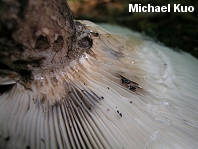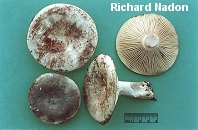Key to 28 Blushing and/or Blackening Russulas in North America 
| 1. | Cap brown, with conspicuous pinkish cottony scales or patches; possibly known only from the type collection made under northern white cedar in Cheboygan County, Michigan. | Russula decora |
| 1. | Cap variously colored (including brown), without pinkish cottony scales; variously distributed. | 2 |
| 2. | Cap evenly yellow; stem and flesh slowly discoloring gray to blackish without a red stage; odor and taste mild; found in conifer and birch bogs in northern and montane North America. | |
| 3. | Cap dull orange to coppery orange; stem and flesh discoloring slowly gray without a red stage; found under conifers; pileocystidia present. | |
| 4. | Cap orangish brown to brownish orange, with fine yellow powder (especially on the margin) when young; stem becoming orangish yellow with age, bruising deep red on handling; odor reminiscent of maraschino cherries or almonds; taste acrid; KOH on cap surface deep red; associated with oaks; apparently widely distributed east of the Great Plains. | |
| 5. | Cap mottled with pinks, purples, and greens (occasionally with browns as well)--or sometimes with one of these shades dominating completely; flesh and stem discoloring slowly pinkish, then gray; odor and taste mild; under conifers in western North America. | Russula occidentalis |
| 6. | Cap red to purple (sometimes mottled with brownish and/or olive shades). | 7 |
| 6. | Cap otherwise colored (white, beige, tan, brown, black). | 19 |
| 8. | Known from California, under Sitka spruce; flesh and stem discoloring gray to black without a red stage; spore print and mature gills yellow; flesh not reacting to phenol; pileocystidia positive in sulphovanillin. | Russula pacifica |
| 8. | Known from eastern North America, under various trees; physical features and chemical reactions varying. | 9 |
| 9. | Stem bruising purplish to dull red but not subsequently blackening; cap small (2-4 cm), almost black over the disc or when young; under spruces. | Russula parvula |
| 9. | Stem discoloring gray to blackish, without a red stage. | 10 |
| 10. | Associated with conifers; taste mild; stem often flushed with pink (inherent color; not discoloration); spore print dull yellow; spores with isolated warts. | Russula vinosa
= Russula obscura |
| 10. | Associated with hardwoods; stem white before discoloring gray with age; spore print white; spores with frequent, fine connectors between warts. | |
| 11. | Cap brownish red, brick red, cinnamon--or with olive shades, or mottled with these colors. | 12 |
| 11. | Cap fairly evenly some shade of red (perhaps with some whitish to yellowish areas when mature or faded). | 14 |
| 12. | Taste slowly very acrid; odor reminiscent of maraschino cherries gone bad; spores with very low warts (extending only to .3 µ). | Russula burkei |
| 12. | Taste mild; odor not distinctive or slightly fishy; spores with low or moderately high warts. | 13 |
| 13. | Spores with very low warts (extending only to .4 µ). | Russula cinerascens |
| 13. | Spores with warts extending .6-1 µ. | Russula seperina |
| 14. | Cap pale red to pink, sometimes with whitish to yellowish areas; spore print and mature gills yellow; taste acrid; spores with low warts extending only to .5 µ; known from lower elevations in California. | Russula californiensis |
| 14. | Not completely as above; physical features varying; taste mild or only slightly acrid; species apparently distributed primarily in eastern North America. | 15 |
| 15. | Stem where bruised turning reddish to red, then blackish. | 16 |
| 15. | Stem where bruised turning gray to blackish without a red stage. | 17 |
| 16. | Cap skin peeling easily over halfway to the center; stem always white before bruising; pileocystidia cylindric to fusiform. | |
| 16. | Cap skin more adnate than above, peeling only near the margin; stem apex sometimes pink (before bruising); pileocystidia clavate. | Russula rubriceps |
| 17. | Associated with hardwoods from the Midwest to northeastern North America; spore print white to creamy. | Russula nigrescentipes |
| 17. | Associated with conifers in northern North America; spore print yellow to orangish yellow. | 18 |
| 18. | Cap purplish red to brownish red; spores with isolated warts; pileocystidia absent; encrusted primordial hyphae present. | Russula vinosa |
| 18. | Cap red to orangish red; spores with connectors between warts; pileocystidia present; encrusted primordial hyphae absent. | Russula paludosa
sensu Shaffer (1970) |
| 19. | Gills pink (inherent color, before discoloring) and well spaced; cap tan to dull brown; stem often bruising pinkish to reddish (without a subsequent change to gray) when very fresh; found in southeastern North America. | |
| 19. | Not completely as above. | 20 |
| 20. | Growing under coast live oak in California; cap beige to tan; flesh and stem bruising reddish to reddish brown but not subsequently turning blackish; gills close, white before discoloring. | Russula cantharellicola |
| 21. | Flesh and/or stem bruising reddish to red, then changing to grayish or blackish. | 22 |
| 21. | Flesh and/or stem bruising grayish to blackish, almost always without a red stage (occasionally some of these mushrooms will manifest a reddish stage). | 25 |
| 22. | Cap olive to olive gray, olive brown, or brownish (not initially whitish); taste acrid; spores partially to completely reticulate with frequent connectors between warts; growing under conifers. | Russula consobrina |
| 22. | Not completely as above. | 23 |
| 23. | Odor heavy and unpleasant, very strong (described as "piggy" and "like . . . a sweating horse"); spore print yellow. | Russula magna |
| 23. | Odor not distinctive, slightly fragrant, or slightly unpleasant; spore print white. | 24 |
| 24. | Pileipellis measuring under 150 µ thick under the microscope, not embedded in a gelatinous matrix--with mostly repent, interwoven elements on the surface; cap surface, when rubbed with a fingertip, often with a somewhat waxy, brittle feel; gills usually (but not always) distant or nearly so. | |
| 24. | Pileipellis over 150 µ thick and embedded in a gelatinous matrix--often with predominantly upright elements near the surface; cap surface usually softer to the touch than above; gills usually (but not always) close or nearly crowded. | |
| 25. | Appearing from the Great Plains eastward. | 26 |
| 25. | Appearing from the Rocky Mountains westward. | 27 |
| 26. | Cap developing brown shades; gills crowded; spore ornamentation up to 0.2 µm high (spores often appearing nearly smooth). | Russula sordida |
| 26. | Cap not developing brown shades; gills close; spore ornamentation up to 0.5 µm high. | |
| 27. | Cap sticky when wet; spore ornamentation up to 0.4 µm high. | Russula adusta |
| 27. | Cap dry; spore ornamentation usually 0.1 µm high (spores appearing nearly smooth). | |
References:
Beardslee, H. C. (1918). The russulas of North Carolina. Journal of the Elisha Mitchell Scientific Society 33: 147–197.
Burlingham, G. S. (1915). Russula. North American Flora 9: 201–236.
Burlingham, G. S. (1924). Notes on species of Russula. Mycologia 16: 16–23.
Kibby, G. & Fatto, R. (1990). Keys to the species of Russula in northeastern North America. Somerville, NJ: Kibby-Fatto Enterprises. 70 pp.
Peck, C. H. (1906). Report of the state botanist: New York species of Russula. Bulletin of the New York State Museum 116: 67–117.
Peck, C. H. (1906). New species of fungi. Bulletin of the Torrey Botanical Club 33: 213–221.
Roberts, C. (2007). Russulas of southern Vancouver Island coastal forests. Doctoral dissertation, University of Victoria. Victoria BC, Canada.
Shaffer, R. L. (1962). The subsection Compactae of Russula. Brittonia 14: 254–284.
Shaffer, R. L. (1970). Notes on the subsection Crassotunicatinae and other species of Russula. Lloydia 33: 49–96.
Thiers, H. D. (1997). New species of Russula from California. Mycotaxon 63: 349–358.
Thiers, H. D. (1997). The Agaricales (gilled fungi) of California 9. Russulaceae I. Russula. Eureka, CA: Mad River P. 158 pp.
This site contains no information about the edibility or toxicity of mushrooms.
Cite this page as:
Kuo, M. (2009, March). North American blushing russulas. Retrieved from the MushroomExpert.Com Web site: http://www.mushroomexpert.com/russulas_rubescent.html
© MushroomExpert.Com



